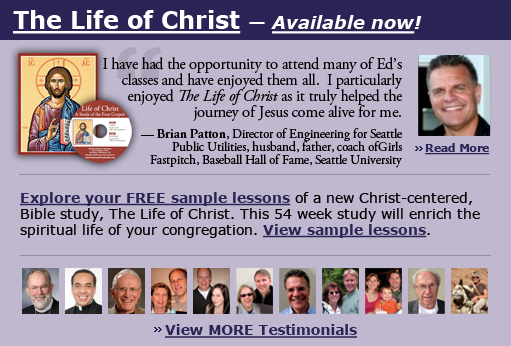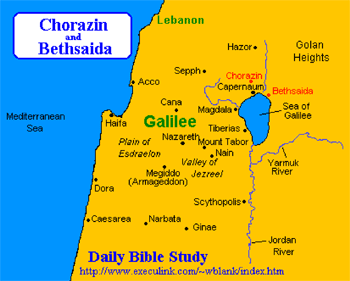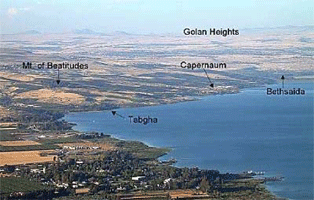
Christmas
Easter
Pentecost
All Saints
Christ The King
Confirmation
Palm/Passion
Reformation
Stewardship
Books of the Bible
Lenten Series
Christmas Dramas
Videos
Series A - Matthew
Series B - Mark
Series C - Luke
Series D - Other
To contact
Edward F. Markquart
info@sfs.com

Series A Gospel Analysis: Five Loaves and Two Fish to Feed 5,000 PENTECOST 11A Matthew 14:13-21 Pastor Edward F. Markquart The following Bible study is from a larger course entitled, THE LIFE OF CHRIST: A Study in the Four Gospels. This 54 week course for the laity will be available for congregations in 2006. Basic text for the course: SYNOPSIS OF THE FOUR GOSPELS, Kurt Aland, English Edition, P. 135-137. #146. FIVE THOUSAND ARE FED Matthew 14:13-21; Mark 6:32-34; Luke 9:10b-17; John 6:1-15 On the following map: Locate the Mediterranean Sea. Locate the Sea of Galilee. The Sea of Galilee is seven miles wide and thirteen miles long. The ancient historian, Josephus, who lived in 37-100 CE immediately after Jesus, first described the lake. Josephus estimated that the Lake of Gennesar was 40 statia wide and 140 stadia long. The lake is really 61 stadia wide (seven miles) and 109 stadia (thirteen miles) long. Locate the Jordan River. Locate the region or county of Galilee. Locate the village of Capernaum which was Jesus’ home in adulthood and the place of eight miracles. Locate the village of Bethsaida which was the city of Philip, Andrew and Peter. Bethsaida was two miles east of Capernaum and on the shores of the Sea of Galilee. Peter, Andrew, and Philip were from Bethsaida. John 1:43-45. "The next day Jesus decided to go to Galilee. And he found Philip and said to him, "Follow me." Now Philip was from Bethsaida, the city of Andrew and Peter.” Locate the village of Chorazin which we will study. Locate the triangle of three adjacent villages, Capernaum, Chorazin, and Bethsaida. Sometimes these villages are called “the evangelical triangle.” From the map study below, notice that these three villages are geographically close together. Locate the city of Tiberias, the city that the Roman emperor built in 18 CE and the Sea of Galilee which became known as the Sea of Tiberias. Locate the village of Magdala, the home village of Mary Magdalene or Mary from Madgala.
http://www.execulink.com/~wblank/20020117.htm http://www.christiananswers.net/bibleplaces/home.html The geography of Jesus: The picture below is a fantastic photograph and needs to be memorized in order to remember many of the most important geographic locations in Jesus’ life. This photograph will be repeated often in this course. Find and focus on the location of Tabgha, the traditional location of the feeding of the 5000.
Identify Capernaum. Christ did eight miracles at Capernaum: the dead daughter of Jairus raised; the evil spirit driven from a man in the synagogue; the paralyzed man let down through the roof and healed; the four disciples catch fish in a miraculous way, Jesus supplied tribute tax money via a fish; the centurion’s servant afflicted with palsy is healed; the son of a nobleman in the king’s court is healed; many others are healed. So the village of Capernaum was very important in Jesus’ healing and teaching ministry. Despite the unique number of miracles done at Capernaum, most of the residents of Capernaum remained unbelievers. It is amazing to us that the people of Capernaum witnessed more miracles and more teachings of Jesus than anyone in Galilee but their hearts were not touched by Jesus. They did not repent and become part of God’s kingdom. "For unto whomsoever much is given, of him shall be much required." (Luke 12:48). The people in Capernaum had been given much but they still did not believe. We, too, can see and experience wonderful miracles of God/Christ all around us, but we too can dismiss those miracles as insignificant and unimportant to us. There were two miracles of Christ that occurred at Bethsaida: Jesus healed a man born blind and he fed the five thousand with five loaves of bread and two fish. Tabgha is known as the traditional sight at which Jesus did the miracle of the feeding of the 5,000. The Biblical text is definite that the feeding of 5,000 was in a remote and lonely place, away from villages and away from places to obtain food. Therefore, it is assumed that Jesus was not in the village of Bethsaida but in the region of Bethsaida. http://www.ancientsandals.com/overviews/tabgha.htm Tabgha - location and profile
“Tabgha was a prosperous fishing village located on the northwestern shore of the Sea of Galilee. The name Tabgha is a corruption of the Greek word Heptapagon which means "seven springs." The water from individual springs there varies in temperature and salinity. (The most saline water from the springs is now being diverted in a channel around the lake.) The warm water from the springs attracted schools of fish, mostly musht, especially in the winter. Tabgha was a fishing suburb of Capernaum, the home and workplace of many who fished in the lake. The movement of the water from the springs at Tabgha was used to turn millstones to grind grain. Craftsmen at Capernaum fashioned these stones from the local basaltic rock, several of which remain near the synagogue there today. Many of the events in Jesus’ ministry, along the north shore of the Sea of Galilee, occurred in the area of Tabgha and Capernaum. Living within a half-hour’s walk of Tabgha, Jesus would have known it well.” (End of website quotation from the above website) The miracle of the feeding of the five thousand is the only miracle told in all four gospel accounts. There are different settings for the feeding of the 5000 in the first three gospels and feeding of the 5000 in the fourth gospel. In the first three gospels, having heard of the gruesome death and beheading of John the Baptist, Jesus withdrew to a lonely place in order to grieve the loss of the Baptist. In the Gospel of John, “after this” is a reference to the previous healing of the handicapped man of thirty-eight years. This event occurred in Jerusalem which was located some eighty miles south of the Sea of Galilee. There is no description in the Gospel of John about Jesus traveling eighty miles from Jerusalem north to the Sea of Galilee in order to feed the 5000. There are many parallels of sequence in all four gospels. Highlight or circle that progression of words/ideas in the gospels e.g.
From the similarity of numerous details and the similarity of the progression of the story, we know that we are reading the same story in all four accounts in our four gospels. The Gospel of John has several unique and distinctive emphases:
The following is a view of Lake Galilee from “The Mountain” where Jesus taught his disciples during the Sermon on the Mount, where Jesus went to pray during the miracle of the feeding of the 5000 (John), and where Jesus went alone to pray before the miracle of the walking on water (Matthew and Mark.) http://www.biblicalisraeltours.com/photos99/1.3.JPG
#146. FIVE THOUSAND ARE FED (The following is a combination of the event from the Gospel of Mark and the Gospel of John.) Mark 6, John 6 We recall that both the Gospels of Mark and John were written by reliable witnesses. The stories in Gospel of Mark are the reminiscences of Simon Peter and the stories in the Gospel of John are the reminiscences of John. In the following event, we are conflating two reliable eyewitness accounts. From the Gospel of Mark -He said to them (his disciples,) "Come away to a deserted place all by yourselves and rest a while." For many were coming and going, and they had no leisure even to eat. And they went away in the boat to a deserted place by themselves. Jesus wanted to have his disciples go to a deserted place and rest a while. Like us on many occasions, we are so busy that we don’t time to eat. Highlight/underline the phrase “no leisure to eat.” That happens to us many times in our lives and Jesus then wants to take us to a quiet place where we can find some rest, time and sanity. Circle the word, “boat.” The disciples and Jesus left the fishing village and were going to travel by boat to a deserted place. We recall from earlier lessons the archeological find of a boat from the time of Jesus. The boat was 26 feet long and had room for 15 passengers.
Note that Matthew tells us that the disciples and Jesus were grieving the death/beheading of John the Baptist. John the Baptist was a first cousin of Jesus and several of Jesus’ disciples were originally disciples of John the Baptist. John the Baptist had baptized Jesus. So all the disciples and Jesus had significant connections to this man who had been viciously beheaded by Herod the Tetrarch. -Now many saw them going and recognized them, and they hurried there on foot from all the towns and arrived ahead of them. The crowd was large and numbered 5000 men, not including women and children. There must have been a dust storm on the shores of Lake Galilee as this massive crowd was following Jesus into a deserted region away from the villages. -As he went ashore, he saw a great crowd; and he had compassion for them, because they were like sheep without a shepherd; and he began to teach them many things. Circle the word, “great,” and write in the words, “5000 plus women and children.” Circle the word, “compassion,” and remember that Jesus had the compassionate mind and heart of God within him. That is the way that God feels towards you and me: compassionate. Underline, “sheep without a shepherd.” This also becomes a primary metaphor of Jesus. Jesus is the Good Shepherd and we are the sheep whom Jesus cares for, feeds, waters, protects, and leads on the wise paths of life. Underline, “he began to each them many things.” We have been studying the parables and miracles of Jesus who continues to teach us today many things. -When it grew late, his disciples came to him and said, "This is a deserted place, and the hour is now very late;send them away so that they may go into the surrounding country and villages and buy something for themselves to eat." The disciples looked at the size of the crowd and told Jesus to send them to villages and the countryside where they could buy something to eat. Like most of us in life, they were not expecting that a miracle would unfold right before their eyes in the coming events. (The next sequence is from the Gospel of John) -When he looked up and saw a large crowd coming toward him, Jesus said to Philip, "Where are we to buy bread for these people to eat?" -He said this to test him, for he himself knew what he was going to do. Jesus tests our hearts to see what is in them. Throughout the whole Gospel of John, Jesus repeatedly knew what he was going to do. Throughout the whole Gospel of John, we will encounter the “omniscience” (all knowingness) of Jesus. -Philip answered him, “Six months’ wages would not buy enough bread for each of them to get a little.” The other gospels tell us two hundred denarii or two hundred days wages would not be enough to buy food for all these people. -One of his disciples, Andrew, Simon Peter's brother, said to him, "There is a boy here who has five barley loaves and two fish. But what are they among so many people?" The first three gospels do not tell us the story of the lad with the five loaves and two fish. Centuries later, readers of the gospels prefer the story with the five loaves and two fish. The boy humanizes the story, and we like this shape of the story better. -Jesus said, "Make the people sit down." John gives us a juicy piece of information. That is, Jesus made the people sit down. -Now there was a great deal of grass in the place; so they sat down, about five thousand in all. Circle the words, “a great deal of grass in this place.” Again, it is a nice, historical, juicy detail.
The crowd was given as much bread and fish as they wanted. There was a superabundance of resources that Jesus had created or found. They were satisfied with the meal that had been given to them. -When they were satisfied, he told his disciples, "Gather up the fragments left over, so that nothing may be lost." So they gathered them up, and from the fragments of the five barley loaves, left by those who had eaten, they filled twelve baskets. Twelve is a symbolic number standing for the twelve tribes of the Old Testament or the twelve disciples/apostles of the New Testament. -When the people saw the sign that he had done, they began to say, "This is indeed the prophet who is to come into the world." This miracle was a sign from Jesus that he was the Son of God who satisfies the hearts of all people. The crowds think that he is THE prophet having returned earth, that Jesus was perhaps Moses or Elijah or some other prophet from the Old Testament. SOME THOUGHTS ABOUT THE MESSAGE AND MEANING OF THIS STORY FOR OUR LIVES
I like what one commentator suggested: Some people want Jesus to change the loaves of the loaves of bread themselves, so that the loaves continually multiply endlessly, so that the loaves themselves experience transformation and become an endless supply of bread. But others suggest that what was really transformed were the selfish hearts of five thousand men; that when these five thousand men saw the example of the boy giving Jesus his five loaves of bread and two fish, these men were inspired to look inside their coats and share the food they had brought with them, hidden inside their clothing. The real transformation then, was not of the loaves, but of five thousand selfish hearts. The Bible says: “A little child shall lead them.” I ask you: Which would be the greater miracle? The transformation of the loaves or the transformation of selfish hearts? I would like to suggest to you that some would prefer to focus on the transformation of the loaves in order to avoid focusing on their own selfish hearts that need to be transformed. Some people focus on the magic of the story in order to avoid the transforming miracle needed in every human heart. There are clear references to Holy Communion in this text. The liturgical references seem clear. “Jesus took the bread...looked up to heaven...gave thanks (gave Eucharist)...broke the bread...gave it to his disciples...who gave it to everyone...and they all ate and were satisfied.” These actions are parallel to Holy Communion. We then read the Gospel of John’s version of this story, and we discover that the feeding of the five thousand is a prelude to Jesus’ teaching that “I am the Bread of life” and Holy Communion. In John, chapter six, we also find the most complete description of Holy Communion in the whole Bible. In John, chapter six, Christ says: “I am the Bread of life. Whoever eats my flesh and drinks my blood, I live in that person and that person lives in me.” “Whoever eats my flesh and drinks my blood will never die but live forever.” Incredible words. Incredible promises. And so in the Gospel of John, chapter six, the feeding of the 5000 is a prelude to Jesus’ teachings about Holy Communion. The two events are directly connected. DISCUSSION QUESTION: IN THE MIRACLE OF THE FIVE LOAVES, TWO FISH AND FEEDING OF THE FIVE THOUSAND, WHAT PART OF THE STORY IS MOST MEANINGFUL TO YOU AND WHY? MIRACLE OF BREADS JN 6 // COLETTE ISABELLA,20,FRA, http://membres.lycos.fr/apax2/images/jn06a/index.htm
Notice that this picture envisions a magical transformation of the fish, so that we see bushels of fish and bushels of bread. We don’t see a miraculous transformation of human hearts in which peoples’ selfishness hearts were transformed and then the people brought the loaves of bread and fish out from underneath their garments where they had been hiding loaves of bread and dried fish. In this course, it is interpreted that “the miracle” was Jesus’ transformation of selfish human hearts into generous human hearts. MIRACLE OF BREADS JN 6 / AURORE,20,FRA, http://membres.lycos.fr/apax2/images/jn06a/index.htm
http://www.stanthonyshrine.org/art_exhibits/Hospitality_art.html http://www.wga.hu/frames-e.html?/html/l/lanfranc/miracle.html
http://kcm.co.kr/bible01/lr/r-154.html
http://kcm.co.kr/bible01/gd/gd163.html
http://www.jesusmafa.com/anglais/imag24.htm
|











